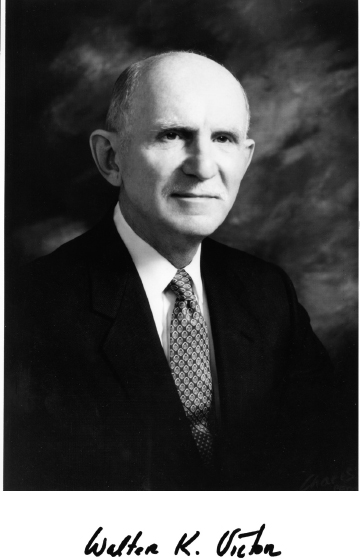1922–2012
Elected in 1990
“For theoretical and practical engineering contributions to satellite and interplanetary command, tracking, navigation, radar, and radio science systems.”
BY JOHN R. CASANI AND CHARLES ELACHI
WALTER K. VICTOR, known as Walt, was born in the Bronx, New York, on December 18, 1922. He graduated with a bachelor of science degree in mechanical engineering from the University of Texas. He was a B-25 pilot in the US Army Air Corps during World War II (May 1943–May 1947), with the rank of 1st Lieutenant, and a flight instructor. After the war he worked in radio engineering before joining the Jet Propulsion Laboratory (JPL) as a research engineer. He was hired into the lab’s missile radio guidance section to work on the MGM-29 Sergeant missile in 1953.
Walt’s first major contribution to space technology was in the development of CODORAC, which stands for coded Doppler radar communications system. Intended to be part of the Sergeant missile’s guided system, it employed pseudo-noise techniques to make the missile guidance unjammable. After the Army chose not to use CODORAC for Sergeant, though, one part of the technology, the phase-locked loop, became the basis of the Microlock tracking and communications system for the United States’ first satellite, Explorer 1.
In 1958 Walt became manager of JPL’s Communications Systems Research section, aiding Eberhardt Rechtin in planning a worldwide network for spacecraft communications. The following year, JPL began building the large antennas for
what was then called its Deep Space Information Facility, first at Goldstone in California and later in Woomera, Australia, and Johannesburg, South Africa, for tracking and communicating with deep space missions.
In 1960–1961 Walt was involved in two other important experiments. He was the project engineer for JPL’s role in the Project Echo experiment, in which radio signals from one 26-meter antenna at Goldstone were relayed to another via a large, orbiting mylar balloon. He was also codirector of JPL’s Venus radar experiment, which used the same pair of antennas to make the first real-time detection of radar signals bounced off Venus in March–May 1961. This experiment refined the length of the astronomical unit and proved that the laboratory would be able to receive the faint signals from spacecraft near Venus.
In 1963 Walt became chief of JPL’s Telecommunication Division and in 1967 deputy assistant laboratory director for the Office of Tracking and Data Acquisition. He held the latter position until 1976. During that time, the Deep Space Information System, renamed Deep Space Network (DSN) in 1963, grew to include seven 26-meter and three 64-meter antennas. Walt also led its transition from analog to digital transmission, reception, and data processing. In 1969 he conceived a substantial reorganization and upgrading of the DSN to improve its performance. He also led the organization through geographic changes, closing the Woomera station and moving its tasks to Tidbinbilla, near Canberra; opening a station outside Madrid, Spain; and eventually shutting down the Johannesburg station.
One key concept that Walt imposed and maintained at the Deep Space Network was that of the Goldstone Duplicate Standard. That meant ensuring that the Australian and Spanish DSN stations were physically and functionally similar to Goldstone to simplify acquisition, training, and maintenance. Another was that of continuous research aimed at incremental improvements in performance.
In 1976 Walt was transferred away from telecommunications and became deputy assistant laboratory director, Office
of Technical Divisions. In 1978 he was promoted to assistant laboratory director for planning and review, responsible for the laboratory’s quality assurance and reliability programs. And in 1985 he was assigned the task of consolidating the laboratory’s computing operations as assistant laboratory director for computing and information services. He retired in 1988.
Richard Mathison, who worked with Walt for more than 20 years, remembered him as a “superb engineer, a strict technical disciplinarian, and a hard but excellent coach. At times, he could be brutally critical. But he always took very good care of his people.” Similarly, Douglas Mudgway wrote of him that “Victor elicited great respect from his coworkers, at both JPL and NASA Headquarters, by virtue of his unequivocal commitment to excellence in every problem, task, or project he addressed.” And University of Southern California (USC) Professor Solomon Golomb, who was deputy section chief of the Telecommunications Research Section under Victor from 1960 until he left for USC in 1963, said that “Victor was a consummate engineer who thoroughly cross-examined everyone who worked for him to be sure they had overlooked no detail in the systems or subsystems they were assigned to design and build. As a result, we knew that if Victor was in charge of a project, it was sure to succeed.”
Walt was an intensely private man who did not socialize and who refused any sort of retirement ceremony after 35 years at JPL. His one hobby was pipe organs, in which he became a local expert.
His daughter Trudy wrote that another hobby was flying. He flew his Cessna airplane across the country from Burbank, California, to New York in 1956 with his young family on board. She also noted that he was a religious man and shared “his devotion and love of music” with his family and close friends.
He was a member of Sigma Xi, a fellow of the Institute of Electrical and Electronics Engineers elected in 1974, elected to the National Academy of Engineering in 1990, and in 1992 he shared the NEC C&C Prize, which is awarded for outstanding contributions in the fields of semiconductors, computers,
or telecommunications, with Eberhardt Rechtin and Andrew Viterbi. He was a corecipient of a NASA Space Act Award in 1963 with Rechtin for his pioneering role in developing the Deep Space Network, and in 1977 he received the NASA Exceptional Service Medal.
Walt died July 25, 2012. He is survived by his children, Trudy Victor Elardo, Daryl Victor, and Walter Victor, five grandchildren, and four great-grandchildren.
The authors wish to acknowledge that the research for this tribute was done by Erik Conway, the JPL historian.







